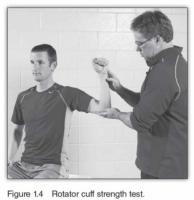Perform a rotator cuff strength test
This is an excerpt from Complete Conditioning for Swimming by David Salo,Scott A Riewald.
Rotator Cuff Strength Test

The four muscles of the rotator cuff (teres minor, infraspinatus, subscapularis, and supraspinatus) are responsible for generating force and stabilizing the shoulder in all of the swimming strokes. The internal rotators tend to become stronger than the external rotators in swimmers, setting up a force imbalance in the shoulder. The rotator cuff strength test examines the strength in the external rotators to determine if additional strengthening of these muscles is needed. This test is best performed by a qualified health care provider.
- In a seated position, raise your left arm out to the side 90 degrees and flex the elbow 90 degrees as well. Your hand should point to the ceiling.
- The examiner should gently stabilize your elbow with one hand while trying to internally rotate your shoulder by pushing on your wrist (see figure 1.4).
- Try to maintain the initial 90-90 position; do not let the examiner rotate your shoulder.
- Based on your strength, the examiner will score you on a scale of 0 to 5. Most swimmers will be rated a 3, 4, or 5.
5 (normal strength): You are able to maintain the 90-90 position without pain when the examiner applies a maximal force.
4 (good strength): You are able to maintain the 90-90 position without pain against a moderate force from the examiner. When a stronger force is applied, the shoulder will move slightly into internal rotation.
3 (fair strength): You are not able to withstand any resistance applied by the examiner.
2 and below (poor strength): You will not even be able to hold the arm in the 90-90 position against gravity without additional support.
A score of 5 is considered normal; anything less indicates you need to strengthen the external rotators.
Learn more about Complete Conditioning for Swimming.
More Excerpts From Complete Conditioning for SwimmingSHOP

Get the latest insights with regular newsletters, plus periodic product information and special insider offers.
JOIN NOW


